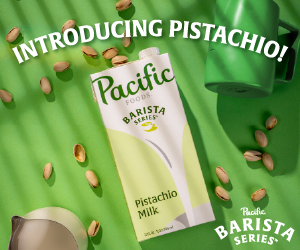This post is part of a special section on build–outs for the contemporary café. Read more posts from the section here.
[B]uilding a small café requires big thinking, not only in procuring usable materials, but also in maximizing available space. As the tiny-house trend explodes, so too does the number of café owners foregoing larger brick-and-mortar stores in favor of compact—and often portable—coffee shops.
In the case of some mobile cafés, space is so limited that it requires painstakingly detailed planning just to have all the proper supplies on hand. Kin Coffee Co. operates out of a small mobile cart, serving coffee on the streets of New York and using the setup to cater events. Kin keeps inventory low intentionally and offers only a limited menu.

“We don’t order in excess,” says Kin co-owner Tabitha Akins. “If someone has fifty guests coming to an event, we buy supplies appropriate for that amount.”
Not only does Kin generate less waste by strategically downsizing orders, they also carry a lighter load, freeing up valuable space.
“We don’t have a lot to transport because we’re purposeful about not having excess,” Tabitha says. “Most catered services either have a stock with a lot of excess, or they purchase an excess and there’s a lot of waste that gets thrown away at every event.”

Because it can be difficult to predict day-to-day business and forecast necessary inventory, other small or mobile shops opt to fit as many supplies as possible in their limited spaces—utilizing every available nook and cranny for storage.
Rolling Roots is a tiny-house building company founded by Mike Razzano and Kenny Crowley in Asheville, North Carolina. To them, tiny-house living means lower building costs, less money for maintenance, and smaller heating bills—not to mention a smaller carbon footprint. Rolling Roots’ first tiny-building project was Le Bon, a boat-shaped mobile coffee shop built on a trailer frame, operated by Mike’s wife, Chantal. Sourcing most of the build-out from recycled materials, Mike and Kenny incorporated plenty of storage and space for Chantal to operate.
“The curved shape of the trailer allowed for a lot more counter space, because it’s right at the widest part of the structure,” Mike says.
Chantal keeps most of the tools she needs readily accessible on her countertops: a sink, a Nuova Simonelli Appia II, two mini-fridges, and a small selection of local pastries. To leave room for workspace on the counters, cups and lids, as well as syrups, chocolates, and extra beans, fit in custom storage containers tucked neatly underneath her counter.
Sometimes tiny-café proprietors also need to utilize the space around them; not every aspect of a functioning coffee shop must be crammed inside of a small build-out.
Story Coffee Co. operates on a twenty-foot-long trailer in Colorado Springs, Colorado, surrounded by a deck with plenty of outdoor seating. Co-owners Don and Carissa Niemeyer worked with designer Robin Pasley to optimize storage and flow in the 160-square-foot space. Doors at either end of the café direct traffic through dedicated entry and exit points. This way, Don says, customers flow into and out of the building without clogging valuable space in the middle of the shop. Windows and natural light provide an open and airy appearance, and supplies stack neatly in cabinets and below-countertop storage bins to minimize clutter. The Niemeyers also devised an inventive method of waste disposal while freeing up even more indoor space.
“There’s a little window behind where the barista stands, and outside of that window is a bin with a thirty-three-gallon trash can in it,” Don says. “When I need to throw out trash, I literally just throw it out the window.”
—Chris Lucia is Fresh Cup’s associate editor.
Contemporary Café Build-Outs
Resourceful Café Build-Outs | Irving Farm Coffee Roasters | Spotlight-Stealing Espresso Machines | Go Green | Henry’s House of Coffee
















